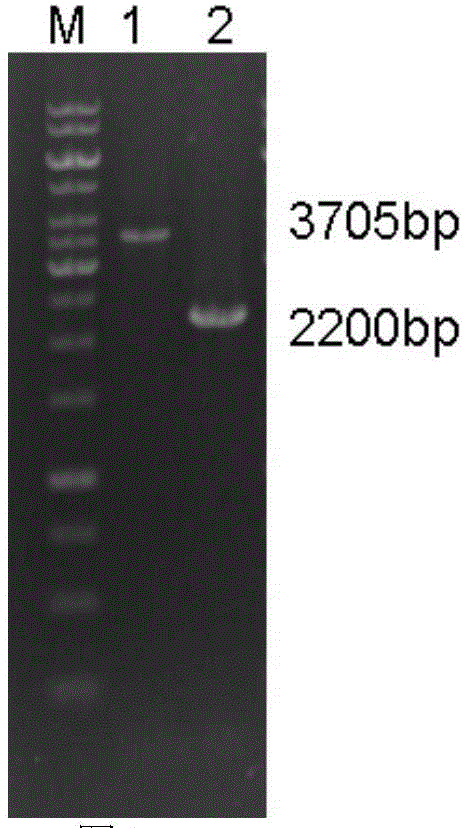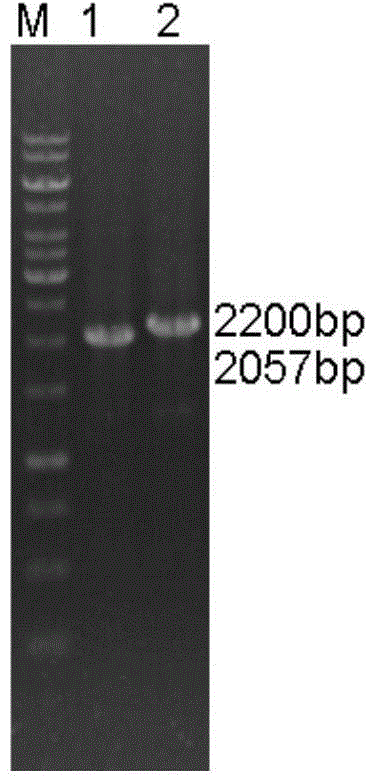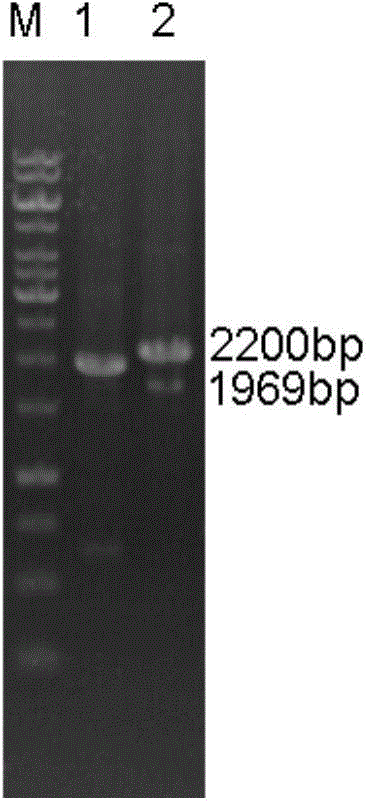Cephalosporin G producing recombinant strain, construction method and applications thereof
The technology of a cephalosporin and a construction method is applied to the recombinant bacteria producing cephalosporin G and the fields of its construction and application, and can solve the problems of high cost and low transformation efficiency of cephalosporins.
- Summary
- Abstract
- Description
- Claims
- Application Information
AI Technical Summary
Problems solved by technology
Method used
Image
Examples
Embodiment 1
[0103] Example 1. Construction of recombinant plasmid pDB1S-H7 expressing deacetoxycephalosporin C synthetase (expandase)
[0104] Design a pair of primers (scDAOCS-F: AACATG CCATGG ACACGACGGTGCCCCACCTTCA and scDAOCS-R: CCG GAATTCTTACTATGCCTTGGATGTGCGGCGCA), using pET30a-H7 as a template (Ji J, Fan K, Tian X, Zhang X, Zhang Y, Yang K. Iterative Combinatorial Mutagenesis as an Effective Strategy for Generation of Deacetoxycephalosporin C Synthase with Improved Activity toward Penicillin G. Applied and environmental microbiology2012,78:7809-7812.), the coding gene (H7) of deacetoxycephalosporin C synthetase (scDAOCS) was amplified by PCR. The PCR conditions are as follows: 95°C, 2min; 95°C, 20sec; 55°C, 20sec (30 cycles); 72°C, 15sec; 72°C, 5min. Detected by 1% agarose gel electrophoresis, the fragment size is about 1000bp, consistent with the target fragment. After the H7 gene was digested with NcoI and EcoRI, the H7 gene fragment was recovered.
[0105] pDB1S ( Figure ...
Embodiment 2
[0107] Embodiment 2, the construction of Escherichia coli mutant PG01, PG02, PG04, PG06, PG08, PG10 and PG12
[0108] In this example, Escherichia coli K12 was subjected to different single gene knockouts to construct PG01, PG02, PG04, PG06, PG08, PG10, PG12 and other single gene knockout strains. The whole genome sequence of Escherichia coli K12 is GenBank Accession: U00096.3 (GI: 545778205, update date is Nov15, 201301:09PM, version is 3).
[0109] 1. Escherichia coli mutant PG01 (purchased from the National Institute of Genetics (NIG, Japan), NIG number JW0715) (Baba et al., 2006) is the α-ketoglutarate dehydrogenase gene of Escherichia coli K12 (sucA) is replaced by the kanamycin resistance gene (about 1300bp) with FRT sites at both ends to knock out (delete) the sucA of E. coli K12 E. coli K12 mutant. It is referred to as PG01 in this application. sucA encodes the protein shown in SEQ ID No.5, and the coding sequence of sucA is shown in SEQ ID No.6. The genotype of PG0...
Embodiment 3
[0167] Embodiment 3, pDB1S-H7 transforms Escherichia coli and its mutants to construct engineering strains
[0168] The pDB1S-H7 in Example 1 was transformed into E. coli K12 and E. coli mutants PG01, PG02, PG04, PG06, PG08, PG10, PG12, PG03, PG14, PG16, PG17, PG18, PG19, PG05, PG15, PG20, PG21 and PG22, on the LB plate containing streptomycin (the concentration of streptomycin is 50 μg / ml), screen positive clones (clones that can grow on the plate containing streptomycin), positive clones Use the primers in Example 1 to carry out PCR verification on scDAOCS-F and scDAOCS-R, which can amplify the deacetoxycephalosporin C synthetase (expandase) gene containing the coding sequence of SEQ ID No.2 The DNA fragments are positive clones. SDS-PAGE electrophoresis after positive clones were induced figure 2 As shown, the desacetoxycephalosporin C synthetase of 34.7 kDa was expressed in each positive clone strain. Among them, the positive clone strain obtained by transforming pDB1S...
PUM
| Property | Measurement | Unit |
|---|---|---|
| concentration | aaaaa | aaaaa |
Abstract
Description
Claims
Application Information
 Login to View More
Login to View More - R&D
- Intellectual Property
- Life Sciences
- Materials
- Tech Scout
- Unparalleled Data Quality
- Higher Quality Content
- 60% Fewer Hallucinations
Browse by: Latest US Patents, China's latest patents, Technical Efficacy Thesaurus, Application Domain, Technology Topic, Popular Technical Reports.
© 2025 PatSnap. All rights reserved.Legal|Privacy policy|Modern Slavery Act Transparency Statement|Sitemap|About US| Contact US: help@patsnap.com



